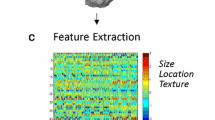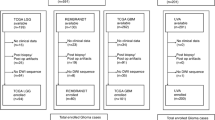Abstract
Adult-type diffuse gliomas are divided into Astrocytoma, IDH-mutant, Oligodendroglioma, IDH-mutant and 1p/19q-codeleted and Glioblastoma, IDH-wildtype based on the IDH mutation, and 1p/19q codeletion status. To determine the treatment strategy for these tumors, pre-operative prediction of IDH mutation and 1p/19q codeletion status might be effective. Computer-aided diagnosis (CADx) systems using machine learning have been noted as innovative diagnostic methods. However, it is difficult to promote the clinical application of machine learning systems at each institute because the support of various specialists is essential. In this study, we established an easy-to-use computer-aided diagnosis system using Microsoft Azure Machine Learning Studio (MAMLS) to predict these statuses. We constructed an analysis model using 258 adult-type diffuse glioma cases from The Cancer Genome Atlas (TCGA) cohort. Using MRI T2-weighted images, the overall accuracy, sensitivity, and specificity for the prediction of IDH mutation and 1p/19q codeletion were 86.9%, 80.9%, and 92.0%, and 94.7%, 94.1%, and 95.1%, respectively. We also constructed an reliable analysis model for the prediction of IDH mutation and 1p/19q codeletion using an independent Nagoya cohort including 202 cases. These analysis models were established within 30 min. This easy-to-use CADx system might be useful for the clinical application of CADx in various institutes.



Similar content being viewed by others
Data availability
The data that support the findings of this study are not openly available due to reasons of sensitivity and are available from the corresponding author upon reasonable request.
References
Suzuki H, Aoki K, Chiba K et al (2015) Mutational landscape and clonal architecture in grade II and III gliomas. Nat Genet 47:458–468
Aoki K, Nakamura H, Suzuki H et al (2018) Prognostic relevance of genetic alterations in diffuse lower-grade gliomas. Neuro Oncol 20:66–77
Brat DJ, Verhaak RG, Aldape KD et al (2015) Comprehensive, integrative genomic analysis of diffuse lower-grade gliomas. N Engl J Med 372:2481–2498
Louis DN, Perry A, Wesseling P et al (2021) The 2021 WHO classification of tumors of the central nervous system: a summary. Neuro Oncol 23:1231–1251
Wijnenga MMJ, French PJ, Dubbink HJ et al (2018) The impact of surgery in molecularly defined low-grade glioma: an integrated clinical, radiological, and molecular analysis. Neuro Oncol 20:103–112
Ding X, Wang Z, Chen D et al (2018) The prognostic value of maximal surgical resection is attenuated in oligodendroglioma subgroups of adult diffuse glioma: a multicenter retrospective study. J Neurooncol 140:591–603
Fukuma R, Yanagisawa T, Kinoshita M et al (2019) Prediction of IDH and TERT promoter mutations in low-grade glioma from magnetic resonance images using a convolutional neural network. Sci Rep 9:20311
Chang K, Bai HX, Zhou H et al (2018) Residual convolutional neural network for the determination of IDH status in low- and high-grade gliomas from MR imaging. Clin Cancer Res 24:1073–1081
Chang P, Grinband J, Weinberg BD et al (2018) Deep-learning convolutional neural networks accurately classify genetic mutations in gliomas. AJNR Am J Neuroradiol 39:1201–1207
Matsui Y, Maruyama T, Nitta M et al (2020) Prediction of lower-grade glioma molecular subtypes using deep learning. J Neurooncol 146:321–327
Nalawade S, Murugesan GK, Vejdani-Jahromi M et al (2019) Classification of brain tumor isocitrate dehydrogenase status using MRI and deep learning. J Med Imaging (Bellingham) 6:046003
Choi YS, Bae S, Chang JH et al (2021) Fully automated hybrid approach to predict the IDH mutation status of gliomas via deep learning and radiomics. Neuro Oncol 23:304–313
van der Voort SR, Incekara F, Wijnenga MMJ et al (2022) Combined molecular subty**, grading, and segmentation of glioma using multi-task deep learning. Neuro Oncol. https://doi.org/10.1093/neuonc/noac166
Kim I, Choi HJ, Ryu JM et al (2019) A predictive model for high/low risk group according to oncotype DX recurrence score using machine learning. Eur J Surg Oncol 45:134–140
Twarish Alhamazani K, Alshudukhi J, Aljaloud S et al (2021) Implementation of machine learning models for the prevention of kidney diseases (CKD) or their derivatives. Comput Intell Neurosci 2021:3941978
Choi S, Park J, Park S et al (2021) Establishment of a prediction tool for ocular trauma patients with machine learning algorithm. Int J Ophthalmol 14:1941–1949
Lorenzo AJ, Rickard M, Braga LH et al (2019) Predictive analytics and modeling employing machine learning technology: the next step in data sharing, analysis, and individualized counseling explored with a large, prospective prenatal hydronephrosis database. Urology 123:204–209
Pawelka D, Laczmanska I, Karpinski P et al (2022) Machine-learning-based Analysis Identifies miRNA expression profile for diagnosis and prediction of colorectal cancer: a preliminary study. Cancer Genomics Proteomics 19:503–511
Park YJ, Bae JH, Shin MH et al (2019) Development of predictive models in patients with epiphora using lacrimal scintigraphy and machine learning. Nucl Med Mol Imaging 53:125–135
Makino Y, Arakawa Y, Yoshioka E et al (2021) Prognostic stratification for IDH-wild-type lower-grade astrocytoma by Sanger sequencing and copy-number alteration analysis with MLPA. Sci Rep 11:14408
Jeuken J, Cornelissen S, Boots-Sprenger S et al (2006) Multiplex ligation-dependent probe amplification: a diagnostic tool for simultaneous identification of different genetic markers in glial tumors. J Mol Diagn 8:433–443
Kanda Y (2013) Investigation of the freely available easy-to-use software ‘EZR’ for medical statistics. Bone Marrow Transplant 48:452–458
Hrapsa I, Florian IA, Susman S et al (2022) External validation of a convolutional neural network for IDH mutation prediction. Medicina (Kaunas) 58:526
**e Y, Zaccagna F, Rundo L et al (2022) Convolutional neural network techniques for brain tumor classification (from 2015 to 2022): review, challenges, and future perspectives. Diagnostics (Basel) 12:1850
Funding
None.
Author information
Authors and Affiliations
Contributions
Conception and design: TN, FO, KA, and RS; development of methodology: TN, FO, KA, and HI; acquisition of clinical and experimental data; TN, SH, KM, JY, SM, YK, HS, AN, and RS; analysis and interpretation of data; TN, FO, KM, and RS: writing of the manuscript; TN, FO, and RS: All authors read and approved the final manuscript.
Corresponding author
Ethics declarations
Conflict of interest
None.
Additional information
Publisher's Note
Springer Nature remains neutral with regard to jurisdictional claims in published maps and institutional affiliations.
Rights and permissions
Springer Nature or its licensor (e.g. a society or other partner) holds exclusive rights to this article under a publishing agreement with the author(s) or other rightsholder(s); author self-archiving of the accepted manuscript version of this article is solely governed by the terms of such publishing agreement and applicable law.
About this article
Cite this article
Nishikawa, T., Ohka, F., Aoki, K. et al. Easy-to-use machine learning system for the prediction of IDH mutation and 1p/19q codeletion using MRI images of adult-type diffuse gliomas. Brain Tumor Pathol 40, 85–92 (2023). https://doi.org/10.1007/s10014-023-00459-4
Received:
Accepted:
Published:
Issue Date:
DOI: https://doi.org/10.1007/s10014-023-00459-4




